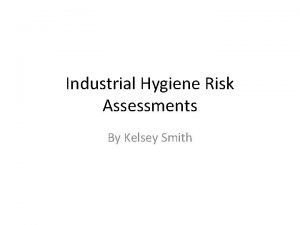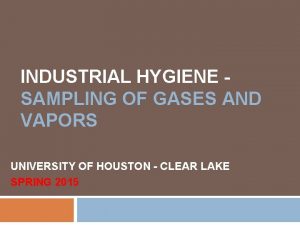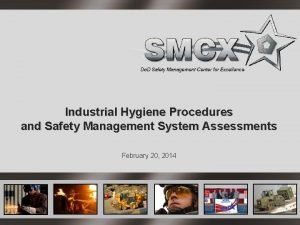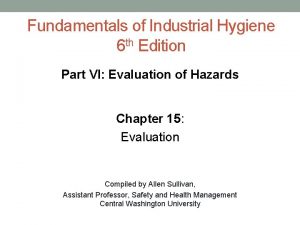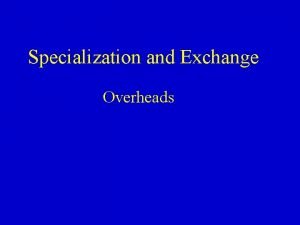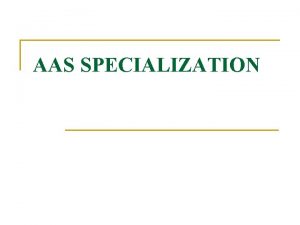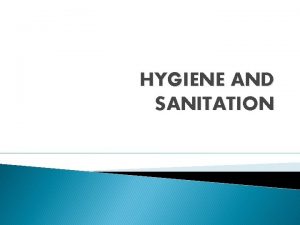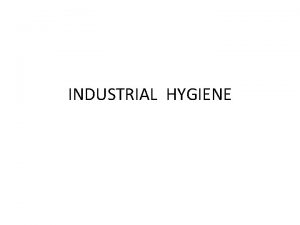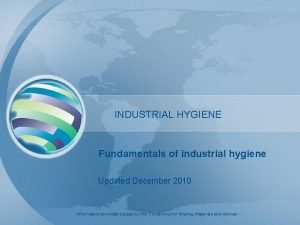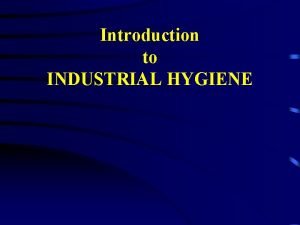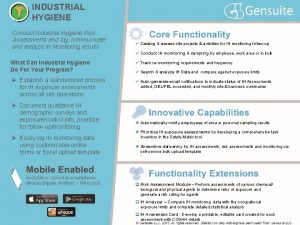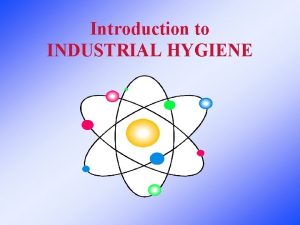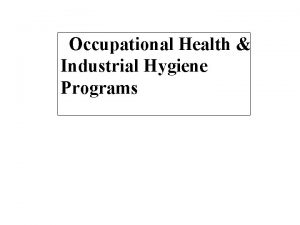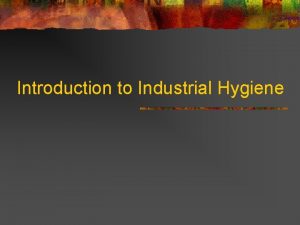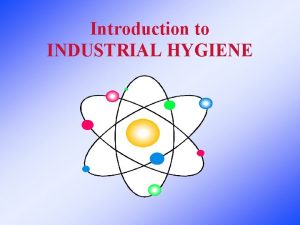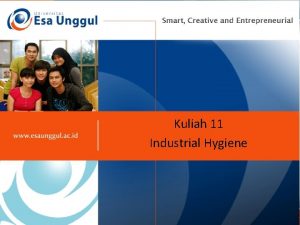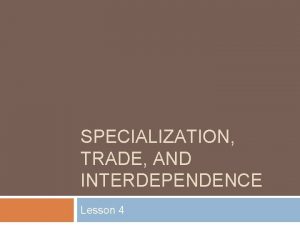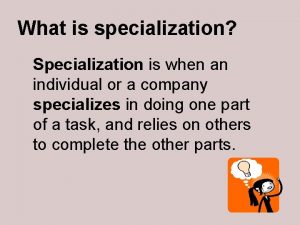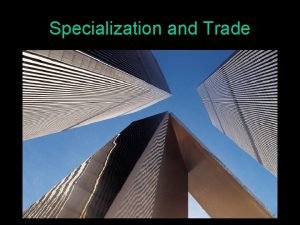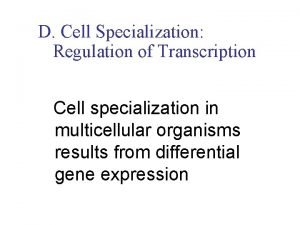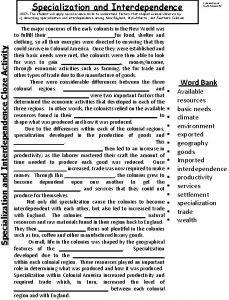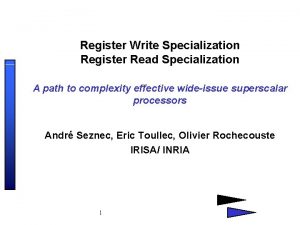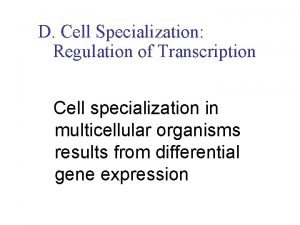Industrial Hygiene Industrial Hygiene A specialization in the


























- Slides: 26

Industrial Hygiene

Industrial Hygiene A specialization in the broad field of safety and health.

OSHAct and Industrial Hygiene t Use Warning Labels t Use proper PPE’s t Provision of medical tests t Maintain accurate records t Accessibility & Availability of tests & monitoring to employees t Notification of employees who have been exposed to environmental stressors

OSHA Process Safety t Coverage t Employee Participation t Process Safety Information t Process Hazard Analysis t Standard Operating Procedures t Requirements for Contractors

MSDS Sheets t General Information t Hazardous Ingredients t Physical & Chemical Characteristics t Fire & Explosive Hazard Data t Health Hazards t Safe Handling and Use t Control Measures

Points of Entry t Inhalation t Absorption t Ingestion t Injection

Effects t Acute y. Sudden dose, high concentrations t Chronic y. Gradual dose over a period of time

Airborne Contaminants t Dusts t Fumes t Smoke t Aerosols t Mists t Gases t Vapors

Effects of Airborne Contaminants t Irritants y. Irritation to the skin, eyes, nose, mouth, throat, and upper respiratory tract t Asphyxiants y. Disrupt breathing so severely that suffocation results t Narcotics

Common Industrial Hygiene Problems t Asbestos t Sick Building Syndrome t Explosive Hazards t Confined Space

Exposure Thresholds t Time Weighted Average (TWA) t Short-term Exposure Limit t Exposure Ceiling

Recognizing Hazards t What is produced? t What raw materials are used? t What additional materials are used in the process? t What equipment is used? t What operational procedures are involved?

Recognizing Hazards t What dust control procedures are involved? t How are accidental spills cleaned up? t How are waste by-products disposed? t Is there adequate ventilation? t Are the processes equipped with exhaust devices?

Recognizing Hazards t How does the facility layout contribute to employee exposure? t Are properly working PPE’s available? t Are safe operating procedures recorded, made available, monitored and enforced?

Control t Engineering Controls t Ventilation t PPE’s t Administrative Controls t Additional Strategies

Important Laws t OSHA Chemical Process Standard t EPA Clean Air Act t SARA t Hazardous Materials Transportation & Uniform Safety Act.

Confined Space Standard t Shutdown Equipment/Power t Test Atmosphere t Ventilate the Space t Have Rescue Personnel Stand By t Maintain Communication t Use a Lifeline

Industrial Safety IT 335 Chapter 16 Noise and Vibration Hazards

Characteristics t Noise y. Unwanted sound t Decibel y. Measurement of sound t Threshold of Hearing y. Sounds heard by the human ear t Threshold of pain y. Max level of sound without experiencing pain

Hearing Loss Factors t Intensity of the Noise t Type of Noise t Daily Duration of Exposure t Total Duration of Exposure t Individual’s age t Coexisting hearing problems t Nature of the Environment t Distance from the source t Position of the ears relative to the sound source

Critical Noise Risk Factors t Noise Level t Frequency t Duration t Distribution

OSHA Regulations t Monitoring Noise Levels t Medical Surveillance t Noise Controls t Personal Protection t Education & Training

Workers’ Comp. & Hearing Loss t Onset and Progress of the employee’s history of hearing loss t The employees complete work history t Results of a hearing exam t Results of hearing studies t Determination of whether the loss originated from outside the workplace

Identifying Noise Hazards t Noise Surveys t Audiometric Testing t Record Keeping t Follow-Up

Noise Controls t Engineering Controls (pg 378 -379) t Administrative Controls (pg 380) t Hearing protection (pg 380)

Preventing Vibration Hazards t Low Vibration tools t Limit Employee Exposure t Change Employee Work Habits
 Industrial hygiene risk assessment
Industrial hygiene risk assessment Wolf
Wolf Industrial hygiene procedure
Industrial hygiene procedure Fundamentals of industrial hygiene
Fundamentals of industrial hygiene Diễn thế sinh thái là
Diễn thế sinh thái là Trời xanh đây là của chúng ta thể thơ
Trời xanh đây là của chúng ta thể thơ Công thức tính thế năng
Công thức tính thế năng đặc điểm cơ thể của người tối cổ
đặc điểm cơ thể của người tối cổ Tỉ lệ cơ thể trẻ em
Tỉ lệ cơ thể trẻ em Các châu lục và đại dương trên thế giới
Các châu lục và đại dương trên thế giới Lời thề hippocrates
Lời thề hippocrates đại từ thay thế
đại từ thay thế Môn thể thao bắt đầu bằng chữ f
Môn thể thao bắt đầu bằng chữ f Sự nuôi và dạy con của hổ
Sự nuôi và dạy con của hổ Cái miệng bé xinh thế chỉ nói điều hay thôi
Cái miệng bé xinh thế chỉ nói điều hay thôi Thế nào là mạng điện lắp đặt kiểu nổi
Thế nào là mạng điện lắp đặt kiểu nổi Hát kết hợp bộ gõ cơ thể
Hát kết hợp bộ gõ cơ thể Dạng đột biến một nhiễm là
Dạng đột biến một nhiễm là Mật thư anh em như thể tay chân
Mật thư anh em như thể tay chân Thế nào là giọng cùng tên? *
Thế nào là giọng cùng tên? * Voi kéo gỗ như thế nào
Voi kéo gỗ như thế nào Thơ thất ngôn tứ tuyệt đường luật
Thơ thất ngôn tứ tuyệt đường luật Thiếu nhi thế giới liên hoan
Thiếu nhi thế giới liên hoan điện thế nghỉ
điện thế nghỉ Thế nào là hệ số cao nhất
Thế nào là hệ số cao nhất Frameset trong html5
Frameset trong html5 Hệ hô hấp
Hệ hô hấp
